

Make Your Own Plastic Bottle Greenhouse. Author: Lucy Debenham BA (hons) - Updated: 30 November 2012| Comment So why on earth would you want to make your own greenhouse out of plastic bottles?
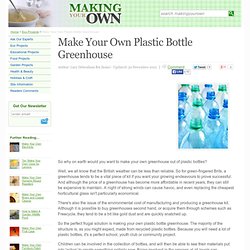
Well, we all know that the British weather can be less than reliable. So for green-fingered Brits, a greenhouse tends to be a vital piece of kit if you want your growing endeavours to prove successful. And although the price of a greenhouse has become more affordable in recent years, they can still be expensive to maintain. There's also the issue of the environmental cost of manufacturing and producing a greenhouse kit. So the perfect frugal solution is making your own plastic bottle greenhouse. Children can be involved in the collection of bottles, and will then be able to see their materials put into 'action' to create something entirely new. Making Your Own Plastic Bottle Greenhouse First Step - Collecting Materials What You'll Need: Around 1500 plastic bottles. It may take a while to collect enough bottles to make the greenhouse. Corners. Seeds of Change Homepage.
Build a Garden in One Day - How to Get Started. One benefit of a raised bed is that you don't need to dig out all the grass.
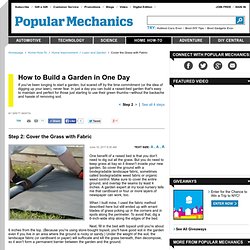
But you do need to keep grass at bay so it doesn't invade your new garden. So cover the ground with a biodegradable landscape fabric, sometimes called biodegradable weed fabric or organic weed control. Make sure to cover the entire ground, and overlap the seams by least 4 inches. A garden expert at my local nursery tells me that cardboard or four or more layers of newspaper can work, too. When I built mine, I used the fabric method described here but still ended up with errant blades of grass poking up in the corners and in spots along the perimeter.
Next, fill in the bed with topsoil until you're about 6 inches from the top. Build a Geodesic Dome Solar Greenhouse to Grow Your Own Food. Gardening. Garden planning. Keyhole Gardens. Keyhole Gardens First made popular in Africa, keyhole gardens are catching on in Texas and other hot, dry places.
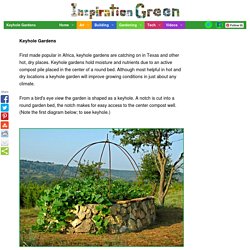
Keyhole gardens hold moisture and nutrients due to an active compost pile placed in the center of a round bed. Although most helpful in hot and dry locations a keyhole garden will improve growing conditions in just about any climate. From a bird's eye view the garden is shaped as a keyhole. A notch is cut into a round garden bed, the notch makes for easy access to the center compost well. Keyhole Garden in Central Texas, Deb Tolman uses keyhole gardens as the main source of her own food supply, and is working on ways to keep them producing throughout multiple seasons and conditions.
Designing and Planting a Medicinal Herb Garden: How to Grow Healing Herbs for Health and Wellbeing. The use of medicinal herbs is a time-honored way of treating everyday conditions such as coughs, colds, scrapes, burns, and other minor ailments.
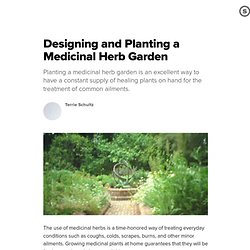
Growing medicinal plants at home guarantees that they will be fresh, organic and always available. Planning a Medicinal Herb Garden Design Herb garden designs range from a simple border along the side of the garage to a formal, intricate knot garden. Here are some aspects of garden design to take into consideration: Site- Plant in a location that receives five to six hours of direct sunlight each day. Choosing Healing Herbs for the Medicinal Herb Garden There are many healing herbs that are easily grown in a medicinal herb garden. Planting an Apothecary Garden. Throughout Europe's Dark Ages, no decent monastery could fail to plant an apothecary garden filled with plants the monks could administer as preventatives and remedies for a variety of ills and ailments.

Although medicine was thoroughly in the dark ages as well, many of these plants had true healing properties. Today, Eastern and alternative medicines enjoy immense popularity, and many drugs used by the Western world are, in fact, derived from many simple garden plants once used by medieval apothecaries. The subsequent article provides tips to install your own apothecary garden for true medieval charm and function. Most medicinal plants and herbs are quite easy to grow and thrive under adequate conditions. Plants gardeners should consider for an apothecary garden include common fennel, Apothecary's Rose, rue, valerian, English lavender, sage, horehound, comfrey, lemon balm, sweet marjoram, thyme, betony, spearmint, peppermint and pot marigold. Garden. Companion Planting. VERMICOMPOSTING. Agriculture / Gardening. Plant Database. Aquaponics. Composting / Fertilizer.
Compost & Worms. Cloves. Worms. Gardening. Zone 5 Vegetable Planting Calendar. To get the most out of your vegetable garden, you need to do a little planning.
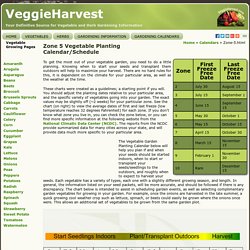
Knowing when to start your seeds and transplant them outdoors will help to maximize your harvest. There are no hard rules for this, it is dependent on the climate for your particular area, as well as the weather at the time. These charts were created as a guidelines; a starting point if you will. You should adjust the planting dates relative to your particular area, and the specific variety of vegetables going into your garden. The exact values may be slightly off (~2 weeks) for your particular zone. Greenhouse & Gardening.